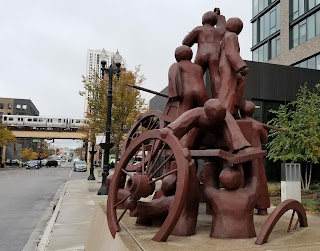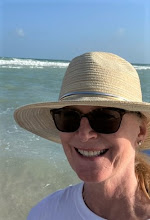Some historical information is included on the plaques.
The monument is easily visible from the street and can be found on Des Plaines Avenue between Randolph and Lake Streets.After the bomb was thrown, police started firing into the crowd, killing 4-8 civilians and wounding 30-60 (sources differ wildly). Seven policemen died, only one directly as a result of the bomb. The other police were killed by what was more than likely friendly fire, and an 8th officer died two years later from complications from his wounds.
The police at this time in Chicago were being used to suppress the nascent labor movement and carry out the interests of the industrial titans of the day. There was also fear and distaste for the German immigrants who were fighting for the rights of the worker. In 1889, a memorial statue of a policeman was installed near the original site to remember the slain police officers. Here's a picture of the original installation.
An inscription on the base reads "In the name of the People of Illinois, I command peace". Seeing as how the gathering was peaceful until the police showed up, many people took exception to this statue. First the crest and seal were stolen from the statue. Then a street car rammed into it. It was vandalized at one point with black paint and blown up twice. Each time it was rebuilt. After the second bombing in 1970, Mayor Daley put a 24-hour guard on it. This expense was mitigated by moving the statue to the lobby of Police Headquarters. In 1976 it was moved again, this time to a courtyard at the Chicago Police Academy. Finally in 2007 it was re-dedicated and installed with a new pedestal at Chicago Police Headquarters at 3501 S State Street. One needs to pass a police checkpoint to see it up close.
The language on the plaques is interesting and very telling. The police were "attacked."
People were happy to wave goodbye to this statue.
After the night of the assembly, hundreds of labor organizers were arrested but only eight went to trial. Anti-labor sentiment was strong and the trial was a joke. All of the men were found guilty with seven of them sentenced to death, based upon very little evidence. Two of the men were proven to not even have been present on the night in question. The sentences of Michael Schwab and Samuel Fielden were later commuted to life in prison and Oscar Neebe was sentenced to 15 years in prison; the other five were to be hung. The day before the execution, Louis Lingg committed suicide in prison by detonating a dynamite cap in his mouth. On November 11, 1887, August Spies, Adolph Fischer, George Engel and Albert Parsons were publicly hung.In 1893, the next governor (Altgeld) pardoned the three surviving men and they lived their last years as free men. Schwab died in 1898, Neebe lived until 1916, and Fielden died in Colorado in 1922 and remains the only Haymarket defendant to not be buried with the others.
In Forest Home Cemetery, the martyrs lie together under this monument.
Albert Spies' last words are engraved here.
The monument appears to be visited regularly.
The words of Governor Altgeld's pardon are inscribed on the back.
There are many books, documentaries, and other historical documents available on the Haymarket tragedy but these monuments exist to remind us all of that history.



































